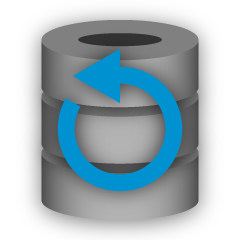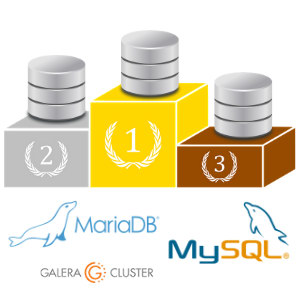One of the cool features in Galera is automatic node provisioning and membership control. If a node fails or loses communication, it will be automatically evicted from the cluster and remain unoperational. As long as the majority of nodes are still communicating (Galera calls this PC - primary component), there is a very high chance the failed node would be able to automatically rejoin, resync and resume the replication once the connectivity is back.
Generally, all Galera nodes are equal. They hold the same data set and same role as masters, capable of handling read and write simultaneously, thanks to Galera group communication and certification-based replication plugin. Therefore, there is actually no failover from the database point-of-view due to this equilibrium. Only from the application side that would require failover, to skip the unoperational nodes while the cluster is partitioned.
In this blog post, we are going to look into understanding how Galera Cluster performs node and cluster recovery in case network partition happens. Just as a side note, we have covered a similar topic in this blog post some time back. Codership has explained Galera's recovery concept in great details in the documentation page, Node Failure and Recovery.
Node Failure and Eviction
In order to understand the recovery, we have to understand how Galera detects the node failure and eviction process first. Let's put this into a controlled test scenario so we can understand the eviction process better. Suppose we have a three-node Galera Cluster as illustrated below:
The following command can be used to retrieve our Galera provider options:
mysql> SHOW VARIABLES LIKE 'wsrep_provider_options'\G
It's a long list, but we just need to focus on some of the parameters to explain the process:
evs.inactive_check_period = PT0.5S;
evs.inactive_timeout = PT15S;
evs.keepalive_period = PT1S;
evs.suspect_timeout = PT5S;
evs.view_forget_timeout = P1D;
gmcast.peer_timeout = PT3S;
First of all, Galera follows ISO 8601 formatting to represent duration. P1D means the duration is one day, while PT15S means the duration is 15 seconds (note the time designator, T, that precedes the time value). For example if one wanted to increase evs.view_forget_timeout to 1 day and a half, one would set P1DT12H, or PT36H.
Considering all hosts haven't been configured with any firewall rules, we use the following script called block_galera.sh on galera2 to simulate a network failure to/from this node:
#!/bin/bash
# block_galera.sh
# galera2, 192.168.55.172
iptables -I INPUT -m tcp -p tcp --dport 4567 -j REJECT
iptables -I INPUT -m tcp -p tcp --dport 3306 -j REJECT
iptables -I OUTPUT -m tcp -p tcp --dport 4567 -j REJECT
iptables -I OUTPUT -m tcp -p tcp --dport 3306 -j REJECT
# print timestamp
date
By executing the script, we get the following output:
$ ./block_galera.sh
Wed Jul 4 16:46:02 UTC 2018
The reported timestamp can be considered as the start of the cluster partitioning, where we lose galera2, while galera1 and galera3 are still online and accessible. At this point, our Galera Cluster architecture is looking something like this:
From Partitioned Node Perspective
On galera2, you will see some printouts inside the MySQL error log. Let's break them out into several parts. The downtime was started around 16:46:02 UTC time and after gmcast.peer_timeout=PT3S, the following appears:
2018-07-04 16:46:05 140454904243968 [Note] WSREP: (62116b35, 'tcp://0.0.0.0:4567') connection to peer 8b2041d6 with addr tcp://192.168.55.173:4567 timed out, no messages seen in PT3S
2018-07-04 16:46:05 140454904243968 [Note] WSREP: (62116b35, 'tcp://0.0.0.0:4567') turning message relay requesting on, nonlive peers: tcp://192.168.55.173:4567
2018-07-04 16:46:06 140454904243968 [Note] WSREP: (62116b35, 'tcp://0.0.0.0:4567') connection to peer 737422d6 with addr tcp://192.168.55.171:4567 timed out, no messages seen in PT3S
2018-07-04 16:46:06 140454904243968 [Note] WSREP: (62116b35, 'tcp://0.0.0.0:4567') reconnecting to 8b2041d6 (tcp://192.168.55.173:4567), attempt 0
As it passed evs.suspect_timeout = PT5S, both nodes galera1 and galera3 are suspected as dead by galera2:
2018-07-04 16:46:07 140454904243968 [Note] WSREP: evs::proto(62116b35, OPERATIONAL, view_id(REG,62116b35,54)) suspecting node: 8b2041d6
2018-07-04 16:46:07 140454904243968 [Note] WSREP: evs::proto(62116b35, OPERATIONAL, view_id(REG,62116b35,54)) suspected node without join message, declaring inactive
2018-07-04 16:46:07 140454904243968 [Note] WSREP: (62116b35, 'tcp://0.0.0.0:4567') reconnecting to 737422d6 (tcp://192.168.55.171:4567), attempt 0
2018-07-04 16:46:08 140454904243968 [Note] WSREP: evs::proto(62116b35, GATHER, view_id(REG,62116b35,54)) suspecting node: 737422d6
2018-07-04 16:46:08 140454904243968 [Note] WSREP: evs::proto(62116b35, GATHER, view_id(REG,62116b35,54)) suspected node without join message, declaring inactive
Then, Galera will revise the current cluster view and the position of this node:
2018-07-04 16:46:09 140454904243968 [Note] WSREP: view(view_id(NON_PRIM,62116b35,54) memb {
62116b35,0
} joined {
} left {
} partitioned {
737422d6,0
8b2041d6,0
})
2018-07-04 16:46:09 140454904243968 [Note] WSREP: view(view_id(NON_PRIM,62116b35,55) memb {
62116b35,0
} joined {
} left {
} partitioned {
737422d6,0
8b2041d6,0
})
With the new cluster view, Galera will perform quorum calculation to decide whether this node is part of the primary component. If the new component sees "primary = no", Galera will demote the local node state from SYNCED to OPEN:
2018-07-04 16:46:09 140454288942848 [Note] WSREP: New COMPONENT: primary = no, bootstrap = no, my_idx = 0, memb_num = 1
2018-07-04 16:46:09 140454288942848 [Note] WSREP: Flow-control interval: [16, 16]
2018-07-04 16:46:09 140454288942848 [Note] WSREP: Trying to continue unpaused monitor
2018-07-04 16:46:09 140454288942848 [Note] WSREP: Received NON-PRIMARY.
2018-07-04 16:46:09 140454288942848 [Note] WSREP: Shifting SYNCED -> OPEN (TO: 2753699)
With the latest change on the cluster view and node state, Galera returns the post-eviction cluster view and global state as below:
2018-07-04 16:46:09 140454222194432 [Note] WSREP: New cluster view: global state: 55238f52-41ee-11e8-852f-3316bdb654bc:2753699, view# -1: non-Primary, number of nodes: 1, my index: 0, protocol version 3
2018-07-04 16:46:09 140454222194432 [Note] WSREP: wsrep_notify_cmd is not defined, skipping notification.
You can see the following global status of galera2 have changed during this period:
mysql> SELECT * FROM information_schema.global_status WHERE variable_name IN ('WSREP_CLUSTER_STATUS','WSREP_LOCAL_STATE_COMMENT','WSREP_CLUSTER_SIZE','WSREP_EVS_DELAYED','WSREP_READY');
+---------------------------+-----------------------------------------------------------------------------------------------------------------------------------+
| VARIABLE_NAME | VARIABLE_VALUE |
+---------------------------+-----------------------------------------------------------------------------------------------------------------------------------+
| WSREP_CLUSTER_SIZE | 1 |
| WSREP_CLUSTER_STATUS | non-Primary |
| WSREP_EVS_DELAYED | 737422d6-7db3-11e8-a2a2-bbe98913baf0:tcp://192.168.55.171:4567:1,8b2041d6-7f62-11e8-87d5-12a76678131f:tcp://192.168.55.173:4567:2 |
| WSREP_LOCAL_STATE_COMMENT | Initialized |
| WSREP_READY | OFF |
+---------------------------+-----------------------------------------------------------------------------------------------------------------------------------+
At this point, MySQL/MariaDB server on galera2 is still accessible (database is listening on 3306 and Galera on 4567) and you can query the mysql system tables and list out the databases and tables. However when you jump into the non-system tables and make a simple query like this:
mysql> SELECT * FROM sbtest1;
ERROR 1047 (08S01): WSREP has not yet prepared node for application use
You will immediately get an error indicating WSREP is loaded but not ready to use by this node, as reported by wsrep_ready status. This is due to the node losing its connection to the Primary Component and it enters the non-operational state (the local node status was changed from SYNCED to OPEN). Data reads from nodes in a non-operational state are considered stale, unless you set wsrep_dirty_reads=ON to permit reads, although Galera still rejects any command that modifies or updates the database.
Finally, Galera will keep on listening and reconnecting to other members in the background infinitely:
2018-07-04 16:47:12 140454904243968 [Note] WSREP: (62116b35, 'tcp://0.0.0.0:4567') reconnecting to 8b2041d6 (tcp://192.168.55.173:4567), attempt 30
2018-07-04 16:47:13 140454904243968 [Note] WSREP: (62116b35, 'tcp://0.0.0.0:4567') reconnecting to 737422d6 (tcp://192.168.55.171:4567), attempt 30
2018-07-04 16:48:20 140454904243968 [Note] WSREP: (62116b35, 'tcp://0.0.0.0:4567') reconnecting to 8b2041d6 (tcp://192.168.55.173:4567), attempt 60
2018-07-04 16:48:22 140454904243968 [Note] WSREP: (62116b35, 'tcp://0.0.0.0:4567') reconnecting to 737422d6 (tcp://192.168.55.171:4567), attempt 60
The eviction process flow by Galera group communication for the partitioned node during network issue can be summarized as below:
- Disconnects from the cluster after gmcast.peer_timeout.
- Suspects other nodes after evs.suspect_timeout.
- Retrieves the new cluster view.
- Performs quorum calculation to determine the node's state.
- Demotes the node from SYNCED to OPEN.
- Attempts to reconnect to the primary component (other Galera nodes) in the background.
From Primary Component Perspective
On galera1 and galera3 respectively, after gmcast.peer_timeout=PT3S, the following appears in the MySQL error log:
2018-07-04 16:46:05 139955510687488 [Note] WSREP: (8b2041d6, 'tcp://0.0.0.0:4567') turning message relay requesting on, nonlive peers: tcp://192.168.55.172:4567
2018-07-04 16:46:06 139955510687488 [Note] WSREP: (8b2041d6, 'tcp://0.0.0.0:4567') reconnecting to 62116b35 (tcp://192.168.55.172:4567), attempt 0
After it passed evs.suspect_timeout = PT5S, galera2 is suspected as dead by galera3 (and galera1):
2018-07-04 16:46:10 139955510687488 [Note] WSREP: evs::proto(8b2041d6, OPERATIONAL, view_id(REG,62116b35,54)) suspecting node: 62116b35
2018-07-04 16:46:10 139955510687488 [Note] WSREP: evs::proto(8b2041d6, OPERATIONAL, view_id(REG,62116b35,54)) suspected node without join message, declaring inactive
Galera checks out if the other nodes respond to the group communication on galera3, it finds galera1 is in primary and stable state:
2018-07-04 16:46:11 139955510687488 [Note] WSREP: declaring 737422d6 at tcp://192.168.55.171:4567 stable
2018-07-04 16:46:11 139955510687488 [Note] WSREP: Node 737422d6 state prim
Galera revises the cluster view of this node (galera3):
2018-07-04 16:46:11 139955510687488 [Note] WSREP: view(view_id(PRIM,737422d6,55) memb {
737422d6,0
8b2041d6,0
} joined {
} left {
} partitioned {
62116b35,0
})
2018-07-04 16:46:11 139955510687488 [Note] WSREP: save pc into disk
Galera then removes the partitioned node from the Primary Component:
2018-07-04 16:46:11 139955510687488 [Note] WSREP: forgetting 62116b35 (tcp://192.168.55.172:4567)
The new Primary Component is now consisted of two nodes, galera1 and galera3:
2018-07-04 16:46:11 139955502294784 [Note] WSREP: New COMPONENT: primary = yes, bootstrap = no, my_idx = 1, memb_num = 2
The Primary Component will exchange the state between each other to agree on the new cluster view and global state:
2018-07-04 16:46:11 139955502294784 [Note] WSREP: STATE EXCHANGE: Waiting for state UUID.
2018-07-04 16:46:11 139955510687488 [Note] WSREP: (8b2041d6, 'tcp://0.0.0.0:4567') turning message relay requesting off
2018-07-04 16:46:11 139955502294784 [Note] WSREP: STATE EXCHANGE: sent state msg: b3d38100-7f66-11e8-8e70-8e3bf680c993
2018-07-04 16:46:11 139955502294784 [Note] WSREP: STATE EXCHANGE: got state msg: b3d38100-7f66-11e8-8e70-8e3bf680c993 from 0 (192.168.55.171)
2018-07-04 16:46:11 139955502294784 [Note] WSREP: STATE EXCHANGE: got state msg: b3d38100-7f66-11e8-8e70-8e3bf680c993 from 1 (192.168.55.173)
Galera calculates and verifies the quorum of the state exchange between online members:
2018-07-04 16:46:11 139955502294784 [Note] WSREP: Quorum results:
version = 4,
component = PRIMARY,
conf_id = 27,
members = 2/2 (joined/total),
act_id = 2753703,
last_appl. = 2753606,
protocols = 0/8/3 (gcs/repl/appl),
group UUID = 55238f52-41ee-11e8-852f-3316bdb654bc
2018-07-04 16:46:11 139955502294784 [Note] WSREP: Flow-control interval: [23, 23]
2018-07-04 16:46:11 139955502294784 [Note] WSREP: Trying to continue unpaused monitor
Galera updates the new cluster view and global state after galera2 eviction:
2018-07-04 16:46:11 139955214169856 [Note] WSREP: New cluster view: global state: 55238f52-41ee-11e8-852f-3316bdb654bc:2753703, view# 28: Primary, number of nodes: 2, my index: 1, protocol version 3
2018-07-04 16:46:11 139955214169856 [Note] WSREP: wsrep_notify_cmd is not defined, skipping notification.
2018-07-04 16:46:11 139955214169856 [Note] WSREP: REPL Protocols: 8 (3, 2)
2018-07-04 16:46:11 139955214169856 [Note] WSREP: Assign initial position for certification: 2753703, protocol version: 3
2018-07-04 16:46:11 139956691814144 [Note] WSREP: Service thread queue flushed.
Clean up the partitioned node (galera2) from the active list:
2018-07-04 16:46:14 139955510687488 [Note] WSREP: cleaning up 62116b35 (tcp://192.168.55.172:4567)
At this point, both galera1 and galera3 will be reporting similar global status:
mysql> SELECT * FROM information_schema.global_status WHERE variable_name IN ('WSREP_CLUSTER_STATUS','WSREP_LOCAL_STATE_COMMENT','WSREP_CLUSTER_SIZE','WSREP_EVS_DELAYED','WSREP_READY');
+---------------------------+------------------------------------------------------------------+
| VARIABLE_NAME | VARIABLE_VALUE |
+---------------------------+------------------------------------------------------------------+
| WSREP_CLUSTER_SIZE | 2 |
| WSREP_CLUSTER_STATUS | Primary |
| WSREP_EVS_DELAYED | 1491abd9-7f6d-11e8-8930-e269b03673d8:tcp://192.168.55.172:4567:1 |
| WSREP_LOCAL_STATE_COMMENT | Synced |
| WSREP_READY | ON |
+---------------------------+------------------------------------------------------------------+
They list out the problematic member in the wsrep_evs_delayed status. Since the local state is "Synced", these nodes are operational and you can redirect the client connections from galera2 to any of them. If this step is inconvenient, consider using a load balancer sitting in front of the database to simplify the connection endpoint from the clients.
Node Recovery and Joining
A partitioned Galera node will keep on attempting to establish connection with the Primary Component infinitely. Let's flush the iptables rules on galera2 to let it connect with the remaining nodes:
# on galera2
$ iptables -F
Once the node is capable of connecting to one of the nodes, Galera will start re-establishing the group communication automatically:
2018-07-09 10:46:34 140075962705664 [Note] WSREP: (1491abd9, 'tcp://0.0.0.0:4567') connection established to 8b2041d6 tcp://192.168.55.173:4567
2018-07-09 10:46:34 140075962705664 [Note] WSREP: (1491abd9, 'tcp://0.0.0.0:4567') connection established to 737422d6 tcp://192.168.55.171:4567
2018-07-09 10:46:34 140075962705664 [Note] WSREP: declaring 737422d6 at tcp://192.168.55.171:4567 stable
2018-07-09 10:46:34 140075962705664 [Note] WSREP: declaring 8b2041d6 at tcp://192.168.55.173:4567 stable
Node galera2 will then connect to one of the Primary Component (in this case is galera1, node ID 737422d6) to get the current cluster view and nodes state:
2018-07-09 10:46:34 140075962705664 [Note] WSREP: Node 737422d6 state prim
2018-07-09 10:46:34 140075962705664 [Note] WSREP: view(view_id(PRIM,1491abd9,142) memb {
1491abd9,0
737422d6,0
8b2041d6,0
} joined {
} left {
} partitioned {
})
2018-07-09 10:46:34 140075962705664 [Note] WSREP: save pc into disk
Galera will then perform state exchange with the rest of the members that can form the Primary Component:
2018-07-09 10:46:34 140075954312960 [Note] WSREP: New COMPONENT: primary = yes, bootstrap = no, my_idx = 0, memb_num = 3
2018-07-09 10:46:34 140075954312960 [Note] WSREP: STATE_EXCHANGE: sent state UUID: 4b23eaa0-8322-11e8-a87e-fe4e0fce2a5f
2018-07-09 10:46:34 140075954312960 [Note] WSREP: STATE EXCHANGE: sent state msg: 4b23eaa0-8322-11e8-a87e-fe4e0fce2a5f
2018-07-09 10:46:34 140075954312960 [Note] WSREP: STATE EXCHANGE: got state msg: 4b23eaa0-8322-11e8-a87e-fe4e0fce2a5f from 0 (192.168.55.172)
2018-07-09 10:46:34 140075954312960 [Note] WSREP: STATE EXCHANGE: got state msg: 4b23eaa0-8322-11e8-a87e-fe4e0fce2a5f from 1 (192.168.55.171)
2018-07-09 10:46:34 140075954312960 [Note] WSREP: STATE EXCHANGE: got state msg: 4b23eaa0-8322-11e8-a87e-fe4e0fce2a5f from 2 (192.168.55.173)
The state exchange allows galera2 to calculate the quorum and produce the following result:
2018-07-09 10:46:34 140075954312960 [Note] WSREP: Quorum results:
version = 4,
component = PRIMARY,
conf_id = 71,
members = 2/3 (joined/total),
act_id = 2836958,
last_appl. = 0,
protocols = 0/8/3 (gcs/repl/appl),
group UUID = 55238f52-41ee-11e8-852f-3316bdb654bc
Galera will then promote the local node state from OPEN to PRIMARY, to start and establish the node connection to the Primary Component:
2018-07-09 10:46:34 140075954312960 [Note] WSREP: Flow-control interval: [28, 28]
2018-07-09 10:46:34 140075954312960 [Note] WSREP: Trying to continue unpaused monitor
2018-07-09 10:46:34 140075954312960 [Note] WSREP: Shifting OPEN -> PRIMARY (TO: 2836958)
As reported by the above line, Galera calculates the gap on how far the node is behind from the cluster. This node requires state transfer to catch up to writeset number 2836958 from 2761994:
2018-07-09 10:46:34 140075929970432 [Note] WSREP: State transfer required:
Group state: 55238f52-41ee-11e8-852f-3316bdb654bc:2836958
Local state: 55238f52-41ee-11e8-852f-3316bdb654bc:2761994
2018-07-09 10:46:34 140075929970432 [Note] WSREP: New cluster view: global state: 55238f52-41ee-11e8-852f-3316bdb654bc:2836958, view# 72: Primary, number of nodes:
3, my index: 0, protocol version 3
2018-07-09 10:46:34 140075929970432 [Warning] WSREP: Gap in state sequence. Need state transfer.
2018-07-09 10:46:34 140075929970432 [Note] WSREP: wsrep_notify_cmd is not defined, skipping notification.
2018-07-09 10:46:34 140075929970432 [Note] WSREP: REPL Protocols: 8 (3, 2)
2018-07-09 10:46:34 140075929970432 [Note] WSREP: Assign initial position for certification: 2836958, protocol version: 3
Galera prepares the IST listener on port 4568 on this node and asks any Synced node in the cluster to become a donor. In this case, Galera automatically picks galera3 (192.168.55.173), or it could also pick a donor from the list under wsrep_sst_donor (if defined) for the syncing operation:
2018-07-09 10:46:34 140075996276480 [Note] WSREP: Service thread queue flushed.
2018-07-09 10:46:34 140075929970432 [Note] WSREP: IST receiver addr using tcp://192.168.55.172:4568
2018-07-09 10:46:34 140075929970432 [Note] WSREP: Prepared IST receiver, listening at: tcp://192.168.55.172:4568
2018-07-09 10:46:34 140075954312960 [Note] WSREP: Member 0.0 (192.168.55.172) requested state transfer from '*any*'. Selected 2.0 (192.168.55.173)(SYNCED) as donor.
It will then change the local node state from PRIMARY to JOINER. At this stage, galera2 is granted with state transfer request and starts to cache write-sets:
2018-07-09 10:46:34 140075954312960 [Note] WSREP: Shifting PRIMARY -> JOINER (TO: 2836958)
2018-07-09 10:46:34 140075929970432 [Note] WSREP: Requesting state transfer: success, donor: 2
2018-07-09 10:46:34 140075929970432 [Note] WSREP: GCache history reset: 55238f52-41ee-11e8-852f-3316bdb654bc:2761994 -> 55238f52-41ee-11e8-852f-3316bdb654bc:2836958
2018-07-09 10:46:34 140075929970432 [Note] WSREP: GCache DEBUG: RingBuffer::seqno_reset(): full reset
Node galera2 starts receiving the missing writesets from the selected donor's gcache (galera3):
2018-07-09 10:46:34 140075954312960 [Note] WSREP: 2.0 (192.168.55.173): State transfer to 0.0 (192.168.55.172) complete.
2018-07-09 10:46:34 140075929970432 [Note] WSREP: Receiving IST: 74964 writesets, seqnos 2761994-2836958
2018-07-09 10:46:34 140075593627392 [Note] WSREP: Receiving IST... 0.0% ( 0/74964 events) complete.
2018-07-09 10:46:34 140075954312960 [Note] WSREP: Member 2.0 (192.168.55.173) synced with group.
2018-07-09 10:46:34 140075962705664 [Note] WSREP: (1491abd9, 'tcp://0.0.0.0:4567') connection established to 737422d6 tcp://192.168.55.171:4567
2018-07-09 10:46:41 140075962705664 [Note] WSREP: (1491abd9, 'tcp://0.0.0.0:4567') turning message relay requesting off
2018-07-09 10:46:44 140075593627392 [Note] WSREP: Receiving IST... 36.0% (27008/74964 events) complete.
2018-07-09 10:46:54 140075593627392 [Note] WSREP: Receiving IST... 71.6% (53696/74964 events) complete.
2018-07-09 10:47:02 140075593627392 [Note] WSREP: Receiving IST...100.0% (74964/74964 events) complete.
2018-07-09 10:47:02 140075929970432 [Note] WSREP: IST received: 55238f52-41ee-11e8-852f-3316bdb654bc:2836958
2018-07-09 10:47:02 140075954312960 [Note] WSREP: 0.0 (192.168.55.172): State transfer from 2.0 (192.168.55.173) complete.
Once all the missing writesets are received and applied, Galera will promote galera2 as JOINED until seqno 2837012:
2018-07-09 10:47:02 140075954312960 [Note] WSREP: Shifting JOINER -> JOINED (TO: 2837012)
2018-07-09 10:47:02 140075954312960 [Note] WSREP: Member 0.0 (192.168.55.172) synced with group.
The node applies any cached writesets in its slave queue and finishes catching up with the cluster. Its slave queue is now empty. Galera will promote galera2 to SYNCED, indicating the node is now operational and ready to serve clients:
2018-07-09 10:47:02 140075954312960 [Note] WSREP: Shifting JOINED -> SYNCED (TO: 2837012)
2018-07-09 10:47:02 140076605892352 [Note] WSREP: Synchronized with group, ready for connections
At this point, all nodes are back operational. You can verify by using the following statements on galera2:
mysql> SELECT * FROM information_schema.global_status WHERE variable_name IN ('WSREP_CLUSTER_STATUS','WSREP_LOCAL_STATE_COMMENT','WSREP_CLUSTER_SIZE','WSREP_EVS_DELAYED','WSREP_READY');
+---------------------------+----------------+
| VARIABLE_NAME | VARIABLE_VALUE |
+---------------------------+----------------+
| WSREP_CLUSTER_SIZE | 3 |
| WSREP_CLUSTER_STATUS | Primary |
| WSREP_EVS_DELAYED | |
| WSREP_LOCAL_STATE_COMMENT | Synced |
| WSREP_READY | ON |
+---------------------------+----------------+
The wsrep_cluster_size reported as 3 and the cluster status is Primary, indicating galera2 is part of the Primary Component. The wsrep_evs_delayed has also been cleared and the local state is now Synced.
The recovery process flow for the partitioned node during network issue can be summarized as below:
- Re-establishes group communication to other nodes.
- Retrieves the cluster view from one of the Primary Component.
- Performs state exchange with the Primary Component and calculates the quorum.
- Changes the local node state from OPEN to PRIMARY.
- Calculates the gap between local node and the cluster.
- Changes the local node state from PRIMARY to JOINER.
- Prepares IST listener/receiver on port 4568.
- Requests state transfer via IST and picks a donor.
- Starts receiving and applying the missing writeset from chosen donor's gcache.
- Changes the local node state from JOINER to JOINED.
- Catches up with the cluster by applying the cached writesets in the slave queue.
- Changes the local node state from JOINED to SYNCED.
Single Console for Your Entire Database Infrastructure
Find out what else is new in ClusterControl
Cluster Failure
A Galera Cluster is considered failed if no primary component (PC) is available. Consider a similar three-node Galera Cluster as depicted in the diagram below:
A cluster is considered operational if all nodes or majority of the nodes are online. Online means they are able to see each other through Galera's replication traffic or group communication. If no traffic is coming in and out from the node, the cluster will send a heartbeat beacon for the node to response in a timely manner. Otherwise, it will be put into the delay or suspected list according to how the node responses.
If a node goes down, let's say node C, the cluster will remain operational because node A and B are still in quorum with 2 votes out of 3 to form a primary component. You should get the following cluster state on A and B:
mysql> SHOW STATUS LIKE 'wsrep_cluster_status';
+----------------------+---------+
| Variable_name | Value |
+----------------------+---------+
| wsrep_cluster_status | Primary |
+----------------------+---------+
If let's say a primary switch went kaput, as illustrated in the following diagram:
At this point, every single node loses communication to each other, and the cluster state will be reported as non-Primary on all nodes (as what happened to galera2 in the previous case). Every node would calculate the quorum and find out that it is the minority (1 vote out of 3) thus losing the quorum, which means no Primary Component is formed and consequently all nodes refuse to serve any data. This is deemed as cluster failure.
Once the network issue is resolved, Galera will automatically re-establish the communication between members, exchange node's states and determine the possibility of reforming the primary component by comparing node state, UUIDs and seqnos. If the probability is there, Galera will merge the primary components as shown in the following lines:
2018-06-27 0:16:57 140203784476416 [Note] WSREP: New COMPONENT: primary = yes, bootstrap = no, my_idx = 2, memb_num = 3
2018-06-27 0:16:57 140203784476416 [Note] WSREP: STATE EXCHANGE: Waiting for state UUID.
2018-06-27 0:16:57 140203784476416 [Note] WSREP: STATE EXCHANGE: sent state msg: 5885911b-795c-11e8-8683-931c85442c7e
2018-06-27 0:16:57 140203784476416 [Note] WSREP: STATE EXCHANGE: got state msg: 5885911b-795c-11e8-8683-931c85442c7e from 0 (192.168.55.171)
2018-06-27 0:16:57 140203784476416 [Note] WSREP: STATE EXCHANGE: got state msg: 5885911b-795c-11e8-8683-931c85442c7e from 1 (192.168.55.172)
2018-06-27 0:16:57 140203784476416 [Note] WSREP: STATE EXCHANGE: got state msg: 5885911b-795c-11e8-8683-931c85442c7e from 2 (192.168.55.173)
2018-06-27 0:16:57 140203784476416 [Warning] WSREP: Quorum: No node with complete state:
Version : 4
Flags : 0x3
Protocols : 0 / 8 / 3
State : NON-PRIMARY
Desync count : 0
Prim state : SYNCED
Prim UUID : 5224a024-791b-11e8-a0ac-8bc6118b0f96
Prim seqno : 5
First seqno : 112714
Last seqno : 112725
Prim JOINED : 3
State UUID : 5885911b-795c-11e8-8683-931c85442c7e
Group UUID : 55238f52-41ee-11e8-852f-3316bdb654bc
Name : '192.168.55.171'
Incoming addr: '192.168.55.171:3306'
Version : 4
Flags : 0x2
Protocols : 0 / 8 / 3
State : NON-PRIMARY
Desync count : 0
Prim state : SYNCED
Prim UUID : 5224a024-791b-11e8-a0ac-8bc6118b0f96
Prim seqno : 5
First seqno : 112714
Last seqno : 112725
Prim JOINED : 3
State UUID : 5885911b-795c-11e8-8683-931c85442c7e
Group UUID : 55238f52-41ee-11e8-852f-3316bdb654bc
Name : '192.168.55.172'
Incoming addr: '192.168.55.172:3306'
Version : 4
Flags : 0x2
Protocols : 0 / 8 / 3
State : NON-PRIMARY
Desync count : 0
Prim state : SYNCED
Prim UUID : 5224a024-791b-11e8-a0ac-8bc6118b0f96
Prim seqno : 5
First seqno : 112714
Last seqno : 112725
Prim JOINED : 3
State UUID : 5885911b-795c-11e8-8683-931c85442c7e
Group UUID : 55238f52-41ee-11e8-852f-3316bdb654bc
Name : '192.168.55.173'
Incoming addr: '192.168.55.173:3306'
2018-06-27 0:16:57 140203784476416 [Note] WSREP: Full re-merge of primary 5224a024-791b-11e8-a0ac-8bc6118b0f96 found: 3 of 3.
2018-06-27 0:16:57 140203784476416 [Note] WSREP: Quorum results:
version = 4,
component = PRIMARY,
conf_id = 5,
members = 3/3 (joined/total),
act_id = 112725,
last_appl. = 112722,
protocols = 0/8/3 (gcs/repl/appl),
group UUID = 55238f52-41ee-11e8-852f-3316bdb654bc
2018-06-27 0:16:57 140203784476416 [Note] WSREP: Flow-control interval: [28, 28]
2018-06-27 0:16:57 140203784476416 [Note] WSREP: Trying to continue unpaused monitor
2018-06-27 0:16:57 140203784476416 [Note] WSREP: Restored state OPEN -> SYNCED (112725)
2018-06-27 0:16:57 140202564110080 [Note] WSREP: New cluster view: global state: 55238f52-41ee-11e8-852f-3316bdb654bc:112725, view# 6: Primary, number of nodes: 3, my index: 2, protocol version 3
A good indicator to know if the re-bootstrapping process is OK is by looking at the following line in the error log:
[Note] WSREP: Synchronized with group, ready for connections
ClusterControl Auto Recovery
ClusterControl comes with node and cluster automatic recovery features, because it oversees and understands the state of all nodes in the cluster. Automatic recovery is by default enabled if the cluster is deployed using ClusterControl. To enable or disable the cluster, simply clicking on the power icon in the summary bar as shown below:
Green icon means automatic recovery is turned on, while red is the opposite. You can monitor the recovery progress from the Activity -> Jobs dialog, like in this case, galera2 was totally inaccessible due to firewall blocking, thus forcing ClusterControl to report the following:
The recovery process will only be commencing after a graceful timeout (30 seconds) to give Galera node a chance to recover itself beforehand. If ClusterControl fails to recover a node or cluster, it will first pull all MySQL error logs from all accessible nodes and will raise the necessary alarms to notify the user via email or by pushing critical events to the third-party integration modules like PagerDuty, VictorOps or Slack. Manual intervention is then required. For Galera Cluster, ClusterControl will keep on trying to recover the failure until you mark the node as under maintenance, or disable the automatic recovery feature.
ClusterControl's automatic recovery is one of most favorite features as voted by our users. It helps you to take the necessary actions quickly, with a complete report on what has been attempted and recommendation steps to troubleshoot further on the issue. For users with support subscriptions, you can look for extra hands by escalating this issue to our technical support team for assistance.
Conclusion
Galera automatic node recovery and membership control are neat features to simplify the cluster management, improve the database reliability and reduce the risk of human error, as commonly haunting other open-source database replication technology like MySQL Replication, Group Replication and PostgreSQL Streaming/Logical Replication.




















































































